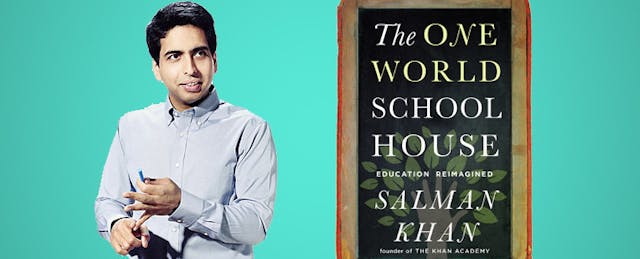The One World Schoolhouse shares Salman Khan’s proposed vision, not solution, for changing education.
This distinction is important. Over the years, the media’s fawning coverage of Khan Academy tends to conflate the two, creating a polarized environment of back-and-forth bickering over what the Khan Academy represents in the ongoing debate over education technology and reform.
The One World Schoolhouse can be considered his manifesto for the future of education, and the ideas, anecdotes, experiences and research that inform it. It is not a prescription for how online learning--or Khan Academy as a whole--will save education. Granted, Khan does not shy away from sharing observations and anecdotal evidence from his work. But this is ultimately less about Khan the Academy than Khan the visionary. The book covers the ideas that shaped Khan’s philosophy, a cursory narrative of how the Academy came to be, and his grand visions for the future of education.
Khan pays homage to a wide body of research as sources of inspiration, from the 1922 Winnetka Plan’s proposal for mastery-based learning, to Nobel Prize-winning research on the biological and neurological effects of learning. (And for the record, he’d like to state that “this notion of ‘flipping the classroom’ was around before Khan Academy existed and clearly wasn’t my idea.”) These ideas and findings are set against the backdrop of the stifling classroom environment of today, which he, like many others, attributes to the 18th century Prussian school model, a recurring punching bag throughout the book. (Poor, poor Prussia.)
His visions for the classrooms of the future are unorthodox and ambitious, which is more reason why the most compelling--but tragically also one of the shortest--part of the book explores his attempt to put these ideas into practice at the Khan Academy Summer Camp. Having 100 students of different ages in one room creating robots, art, music, playing board games, and working on Khan Academy lessons (but only for one or two hours, he emphasizes!), may sound like a recipe for a cacophonous headache. But this “organized chaos” represents his best attempt at testing and realizing his bold vision. And this discussion certainly deserves more than a mere four pages!
For all the buzz about Salman Khan as a “pioneer in integrating technology and learning,” (to quote Bill Gates from the book’s back cover), the book is surprisingly sparse on the technical specifics of how Khan goes about doing so. A deep dive into the details behind his platform may be outside the purview of the book. But there are times when Khan makes casual assumptions about the capability of technology without offering much in the way of practical evidence. For example, he repeatedly stresses importance of topic mastery, and where technology can assist. But at the same time, he admits that his platform assesses proficiency based on a “get ten right answers in a row” heuristic--not particularly impressive to subject experts and the pedagogically-minded.
The book concludes with a chapter on “Making Time for Creativity,” which one may find strange given that what he’s probably best known for, YouTube videos, aren’t necessarily fitting for the phrase. But he clearly wants to to establish a legacy that extends beyond that. That Khan challenges old assumptions and makes new ones throughout the book is a sign of his willingness to experiment with other ways to achieve his vision. And if his well-mannered responses to recent criticisms of his videos are any indication, he’s more than happy to be challenged himself.
“Is Khan Academy, along with the intuitions and ideas that underpin it, our best chance to move toward a better educational future? That's not for me to say. Other people of vision and goodwill have differing approaches, and I fervently hope that all are given a fair trial in the wider world.”


